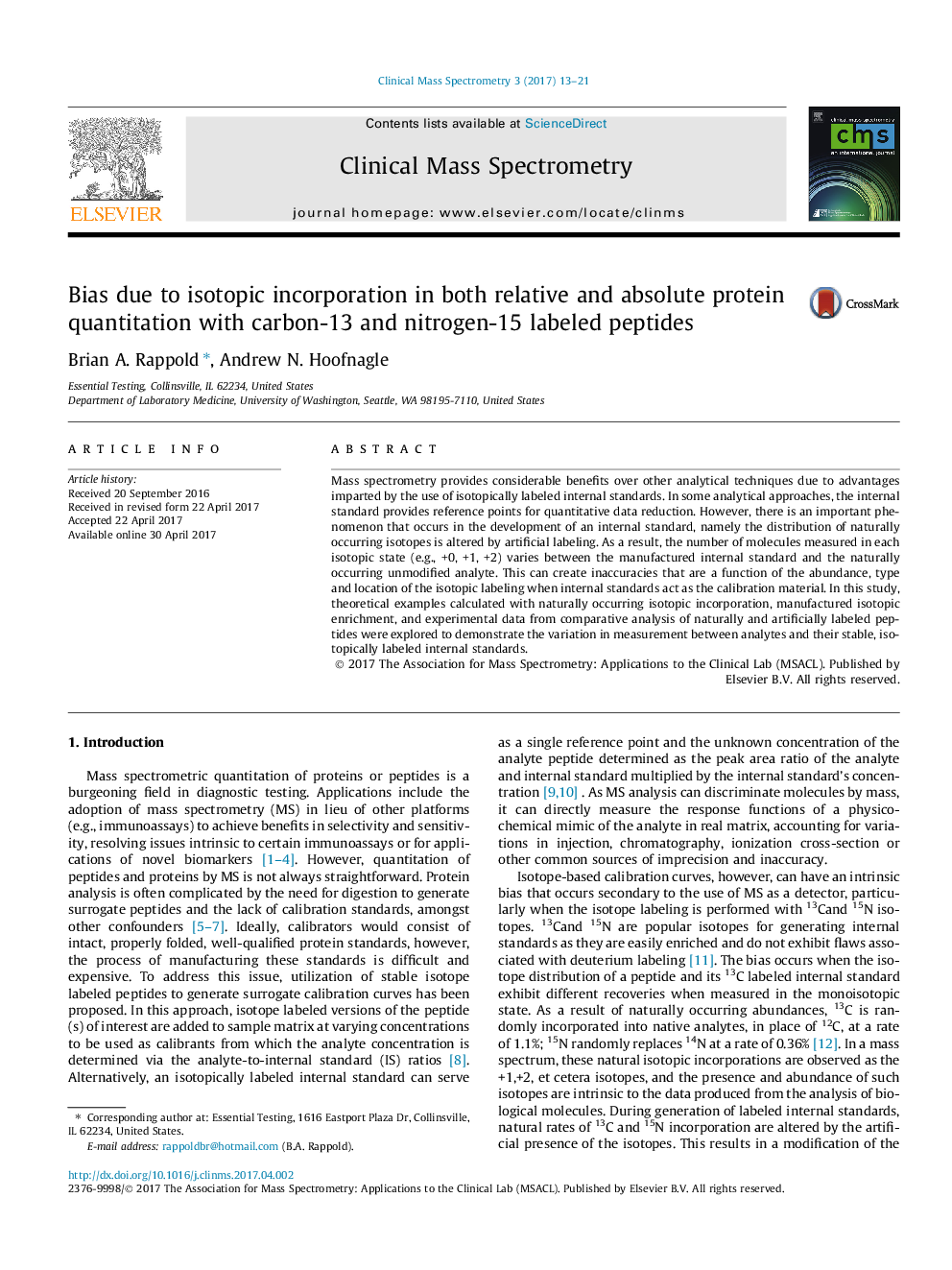| کد مقاله | کد نشریه | سال انتشار | مقاله انگلیسی | نسخه تمام متن |
|---|---|---|---|---|
| 8917894 | 1642795 | 2017 | 9 صفحه PDF | دانلود رایگان |
عنوان انگلیسی مقاله ISI
Bias due to isotopic incorporation in both relative and absolute protein quantitation with carbon-13 and nitrogen-15 labeled peptides
ترجمه فارسی عنوان
تقاربی ناشی از ترکیب ایزوتوپ در هر دو مقدار نسبی و مطلق پروتئین با پپتید های مارکر کربن 13 و نیتروژن 15
دانلود مقاله + سفارش ترجمه
دانلود مقاله ISI انگلیسی
رایگان برای ایرانیان
ترجمه چکیده
طیف سنجی جرم در مقایسه با سایر تکنیک های تحلیلی به دلیل مزیت های استفاده شده از استانداردهای داخلی با برچسب های ایزوتوپیک، مزایای قابل توجهی دارد. در برخی رویکردهای تحلیلی، استاندارد داخلی، مرجع برای کاهش داده های کمی را فراهم می کند. با این حال، یک پدیده مهم وجود دارد که در توسعه یک استاندارد داخلی رخ می دهد، یعنی توزیع ایزوتوپ های طبیعی که توسط برچسب های مصنوعی تغییر می کند. در نتیجه، تعداد مولکولهای اندازه گیری شده در هر حالت ایزوتوپ (به عنوان مثال +0، +1، +2) بین استاندارد داخلی تولید شده و آنالیتور غیر متداول طبیعی متفاوت است. این می تواند اشتباهاتی را ایجاد کند که عملکرد فراوانی، نوع و مکان نشانه ایزوتوپ است، زمانی که استانداردهای داخلی به عنوان مواد کالیبراسیون عمل می کنند. در این مطالعه، نمونه های نظری محاسبه شده با ترکیب ایزوتوپ طبیعی، غنی سازی ایزوتوپ تولید شده و داده های تجربی از تجزیه و تحلیل تطبیقی پپتیدهای طبیعی و مصنوعی برچسب گذاری شده اند تا نشان دهندۀ تغییرات در اندازه گیری بین آنالیت ها و استانداردهای پایدار و ایزوتوپ داخلی آنها است.
موضوعات مرتبط
مهندسی و علوم پایه
شیمی
طیف سنجی
چکیده انگلیسی
Mass spectrometry provides considerable benefits over other analytical techniques due to advantages imparted by the use of isotopically labeled internal standards. In some analytical approaches, the internal standard provides reference points for quantitative data reduction. However, there is an important phenomenon that occurs in the development of an internal standard, namely the distribution of naturally occurring isotopes is altered by artificial labeling. As a result, the number of molecules measured in each isotopic state (e.g., +0, +1, +2) varies between the manufactured internal standard and the naturally occurring unmodified analyte. This can create inaccuracies that are a function of the abundance, type and location of the isotopic labeling when internal standards act as the calibration material. In this study, theoretical examples calculated with naturally occurring isotopic incorporation, manufactured isotopic enrichment, and experimental data from comparative analysis of naturally and artificially labeled peptides were explored to demonstrate the variation in measurement between analytes and their stable, isotopically labeled internal standards.
ناشر
Database: Elsevier - ScienceDirect (ساینس دایرکت)
Journal: Clinical Mass Spectrometry - Volume 3, January 2017, Pages 13-21
Journal: Clinical Mass Spectrometry - Volume 3, January 2017, Pages 13-21
نویسندگان
Brian A. Rappold, Andrew N. Hoofnagle,
